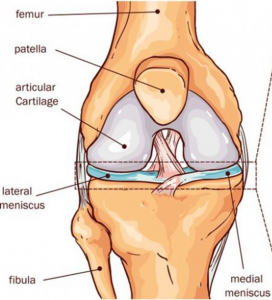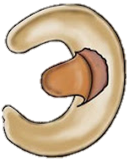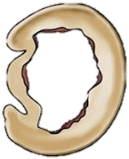Like a lot of knee injuries, a meniscus tear can be painful and debilitating. Unfortunately, it’s quite common. In fact, a meniscal tear is one of the most frequently occurring cartilage injuries of the knee. The meniscus is a piece of cartilage that provides a cushion between your femur and tibia.
There are two menisci in each knee joint.They can be damaged or torn during activities that put pressure on or rotate the knee joint.
You don’t have to be an athlete to get a meniscus tear. Simply getting up too quickly from a squatting position can also cause a meniscal tear.
Symptoms
- Pain in the knee
- Swelling
- A popping sensation during the injury
- Difficulty bending and straightening the leg
- A tendency for your knee to get “stuck” or lock up
Anatomy

Types Of Tears

An intrasubstance tear is a common finding on an MRI report. Often these are a sign of early degenerative changes of the meniscus tissue. They are stable injuries, and generally do not require any surgical treatment.
This type of tear can progress to a Bucket-Handle tear

Radial tears are the most common type of tear. They are within the area of the meniscus, where there is no blood supply, and therefore difficult to heal. Usually, these tears require some type of surgical treatment to cut away the tear.
This type of tear can progress to a Complex tear

A horizontal tear is a tear that most commonly requires a meniscus repair. Rather than removing the damaged portion of the meniscus, a horizontal tear may be able to be sewn together.
This type of tear can progress to a Flap tear

A flap tear of the meniscus is an unusual pattern of a meniscal tear. In circumstances where the flap is causing symptoms of catching in the knee, the flap of the meniscus can usually be removed without removing much tissue at all

A complex tear means there is a combination of tear patterns. A complex tear often involves both radial and horizontal tear patterns. Typically complex tears are not treated with meniscus repair because of the complex nature of the tear

A bucket-handle tear is a large type of horizontal tear of the meniscus. These types of tears often cause the knee to become stuck by causing the torn portion of the meniscus to block normal knee motion. Bucket-handle tears often require more surgical interventions in order to allow the knee to start bending again
Causes
The meniscus can be torn during activities that cause direct contact or pressure from a forced twist or rotation. A sudden pivot or turn, deep squatting, or heavy lifting can all lead to meniscal tears. Athletes that play sports such as football, rugby, netball and tennis have these risks. If you have osteoarthritis, you’re at higher risk of injuring your knee or tearing your meniscus.
Prevention
Meniscus tears are tough to prevent since they’re usually the result of an accident. But some precautions might lower the risks of a knee injury.
You should:
- Keep your thigh muscles strong with regular exercises.
- Warm up with light activities before taking part
- Give your body time to rest between workouts. Fatigued muscles can increase your risk of injury.
- Make sure your shoes have enough support and fit correctly.
- Maintain flexibility.
- Never abruptly increase the intensity of your workout.
Treatment
Treatment for a torn meniscus often begins conservatively, depending on the type, size and location of your tear. Many tears that aren’t associated with locking or a block to knee motion will become less painful over time, so they don’t require surgery.
If your knee remains painful despite rehabilitative therapy or if your knee locks, your doctor might recommend surgery. It’s sometimes possible to repair a torn meniscus, especially in children and young adults.
If the tear can’t be repaired, the meniscus might be surgically trimmed, possibly through tiny incisions using an arthroscope. After surgery, you will need to do exercises to increase and maintain knee strength and stability.
Strengthening the muscles around the knee and throughout the leg helps ease pressure on the healing knee tissue as well as provide stability when standing and walking.
Stretching exercises may include range of motion exercises to improve bending and straightening out the knee.
Contact Me
Let's chat!
Need more information? Send me an email or drop me a line. I don’t bite!
- Charlotte@rehabontheroad.co.uk
- 07971448719
